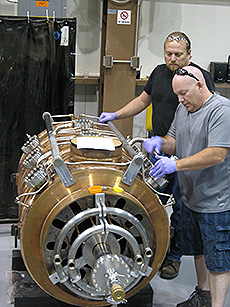Fermilab accelerator complex starts up after long shutdown
 |
Bill Dymond (foreground) and Paul Schild, AD, work on one of the new 53-MHz cavities for the Recycler upgrade. Photo: Denton Morris, AD
|
A beam of protons whizzed through the Main Injector for the first time in over a year on July 30, representing a major milestone in the year-long process of overhauling the Fermilab accelerator complex. The upgrade will eventually culminate in an accelerator with double the power it had previously.
"The shutdown has been challenging, and we all look forward to returning to beam operations and providing beam to the experiments," said Dave Capista, an engineering physicist in the Accelerator Division. "It is exciting for us to see the results of our hard work."
The upgraded accelerator complex will push the laboratory's Intensity Frontier program forward, ultimately delivering high-intensity beams efficiently to the many current experiments that use it and to the future Muon g-2 and Mu2e experiments.
Upgrading the complex requires an elaborate choreography of four main pieces: the Linac, the Booster, the Recycler and the Main Injector. Prior to the 2012 shutdown, the Main Injector and Recycler operated mostly independently. The primary change in the new system is the ability to move beam manipulation functions out of the Main Injector and into the Recycler, allowing the two to coordinate operations to deliver more beam in less time, resulting in more powerful beams.
Now that the Main Injector has seen beam, the laboratory will begin gradually ramping up accelerator operations.
With the Main Injector now operational, it can send low-intensity beam to the NuMI target and the Switchyard so experiments such as NOvA and SeaQuest can begin to commission their equipment. Within a few weeks, the Accelerator Division hopes to begin running beam through the Recycler so commissioning can begin there as well.
"Once you have all the equipment functioning and doing its job, then it's a case of sitting down and doing the tuning and understanding how the machine behaves," said Phil Adamson, a scientist in the Main Injector Department. "It'll be a fun period. There are a lot of systems, so there are a lot of things to do. It will take time."
Although the Recycler isn't operational yet, in the coming months the Accelerator Division will begin running beam through it and hope to have the Recycler and Main Injector working together by the end of the year. Ultimately, the Fermilab accelerator will deliver beams of up to 700 kilowatts, instead of the current maximum of 350.
"It's simply about trying to deliver as much as we can to all the customers that we have," said Duane Newhart, deputy department head of the Operations Department. "We have a lot. And we hope to have more."
As the beam is ramped up to greater intensities, the Accelerator Division will monitor how the machines handle it and make adjustments as it goes along.
"When you get to the highest intensities, that's where you find all the edges," Adamson said. "At the lower intensities everything works fairly easily, but when you start pushing intensity as high as you can go, all the interesting features start to show up."
Fermilab will celebrate the restart of the accelerator complex in the fall.
—Laura Dattaro
|